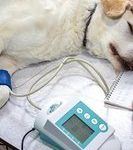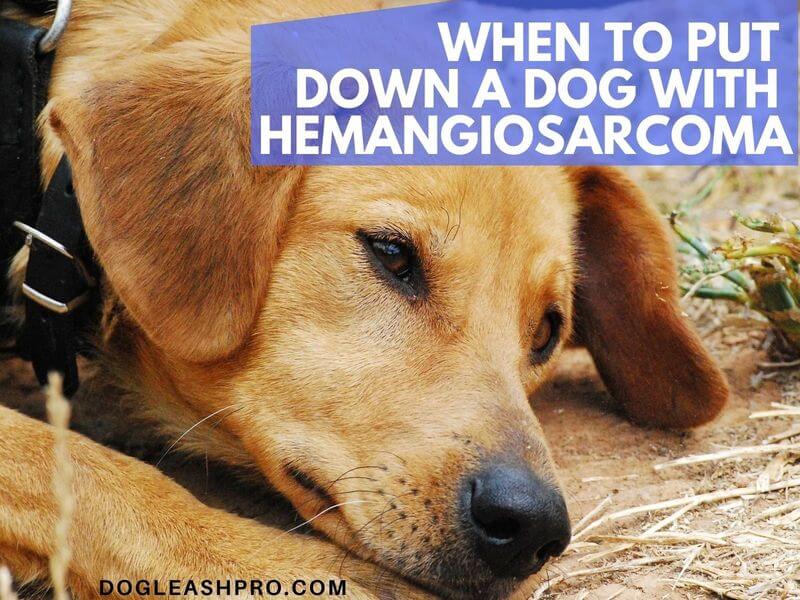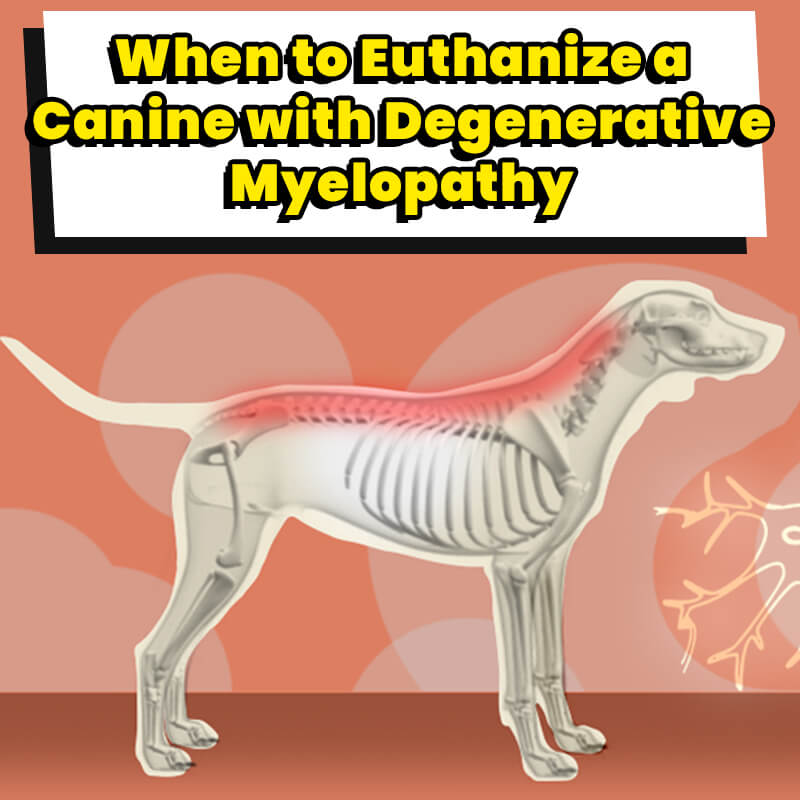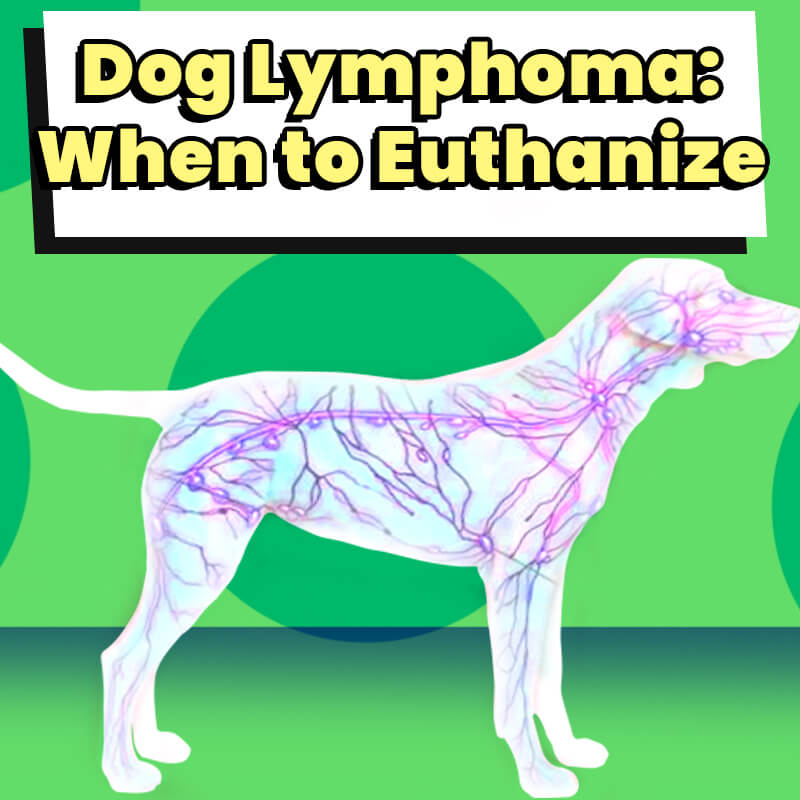
Last year my best friend’s Rottweiler was diagnosed with bone cancer. She eventually had to make the difficult decision to euthanize her dog with osteosarcoma. She wishes she knew more about OSA and inspired me to write this blog.
When to put down a dog with osteosarcoma? The right time to euthanize a dog with Osteosarcoma is when your dog is suffering from pain, has difficulty eating, and overall living a poor quality of life. Speak with your vet first to see if it is the right time to put your dog down.
Osteosarcoma is extremely aggressive and some of the dog breeds most commonly affected by this disease are also prone to torn ACL injuries so be sure to check our blog on when to put a dog down with torn ACL to rule out other possible conditions.
If you’re feeling confused like my best friend was, I hope this article provides you with a clearer understanding of what canine osteosarcoma is and when the right time to put down your dog may be.
Table of Contents
What is Osteosarcoma in dogs?
Osteosarcoma is the most common aggressive bone disease in dogs. Considered a primary bone cancer, it’s when a mass of bone cell tumor begins to grow deep inside the dog’s bone and spread to destroy healthy bone cells.
The disease usually develops in the limbs although it can develop in any bone. According to VeterinaryPartner, appendicular osteosarcoma or bone tumor occurring on a leg accounts for 75% to 85% of all bone tumors in dogs.
When the cancer progresses, the dog will feel a lot of pain because their bone is destroyed from the inside out. The cancerous cells can also spread to other parts of the body such as the lungs.
The Canine Health Foundation noted that the most common form of bone cancer in dogs in the United States is osteosarcoma. About 10,000 dogs in the U.S. are affected by this crippling bone cancer each year.
While osteosarcoma can occur at any age, it usually occurs in middle to elderly-aged dogs. The average age of bone cancer appearing in dogs is usually 7 to 8 years of age with peak onset by around 15 years of age.
What causes osteosarcoma in dogs?
What causes osteosarcoma in dogs is not straightforward. There is no single known cause. It could be caused by a multiplex of risk factors, including environmental, genetic, or hereditary.
Recent studies reported that 70% of osteosarcoma cases are passed down genetically between dogs. This life-threatening form of cancer is very aggressive and affects mainly large dog breeds.
Helping you decide when to euthanize your dog with Osteosarcoma
Contact your veterinarian if you suspect your dog may be suffering from Osteosarcoma. There are several factors and steps to consider if your dog has been officially diagnosed with OSA. The steps below will guide you in the right direction and answer any questions you may have.

Total Time Needed :
1
Month
30
Minutes
Total Cost:
50
USD to 300+ USD
Required Tools:
Things Needed?
Steps to decide if you should euthanize your dog with Osteosarcoma:
Canine osteosarcoma symptoms
There are several symptoms associated with canine osteosarcoma including joint or bone pain and swelling. You’ll notice intermittent periods of lameness in which the dog may not be able to use one or more of its limbs due to the pain.
Once the dog starts to show lameness, it only takes up to 3 months to go from intermittent to constant. For example, in the first month, the pain may start and stop at intervals. At 3 months, the pain is persistent and consistently recur over time.
As the tumor grows, the swelling becomes more obvious. Swelling can appear suddenly and progress quickly or steadily.
The limb becomes weak because the tumorous bone replaces the normal bone. Dogs with this cancerous tumor have fragile limbs that can break with a minor injury.
Broken bones caused by canine osteosarcoma is known as a pathologic fracture. Sadly this type of fracture bone does not heal so many vets do not attempt to perform surgery or put on casts. It’s usually when dogs suffer from pathologic fracture that confirms the diagnosis of osteosarcoma.
Dogs with osteosarcoma may also experience loss of appetite and lethargy. When you notice this, metastasis has occurred in which cancer has spread to other parts of the dog’s body.

Dog breed prone to osteosarcoma
Osteosarcoma usually affects the leg bones of large and giant dog breeds. Large and tall dog breeds tend to develop tumors when they’re younger. Pup as young as 6 months old can develop osteosarcoma.
Below are dog breeds that are most commonly affected by osteosarcoma:
- Bernese Mountain Dogs
- Borzois
- Boxer Dogs
- Doberman Pinschers
- German shepherd dogs
- Golden Retrievers
- Great Danes
- Greyhounds
- Irish Setters
- Irish Wolfhounds
- Labrador Retrievers
- Leonbergers
- Rottweilers
- Saint Bernards
- Scottish Deerhounds
- Weimaraners
Additionally, older and heavy dogs have a higher chance of contracting osteosarcoma. For instance, dogs that are over 90 pounds account for about a third of all osteosarcoma cases.
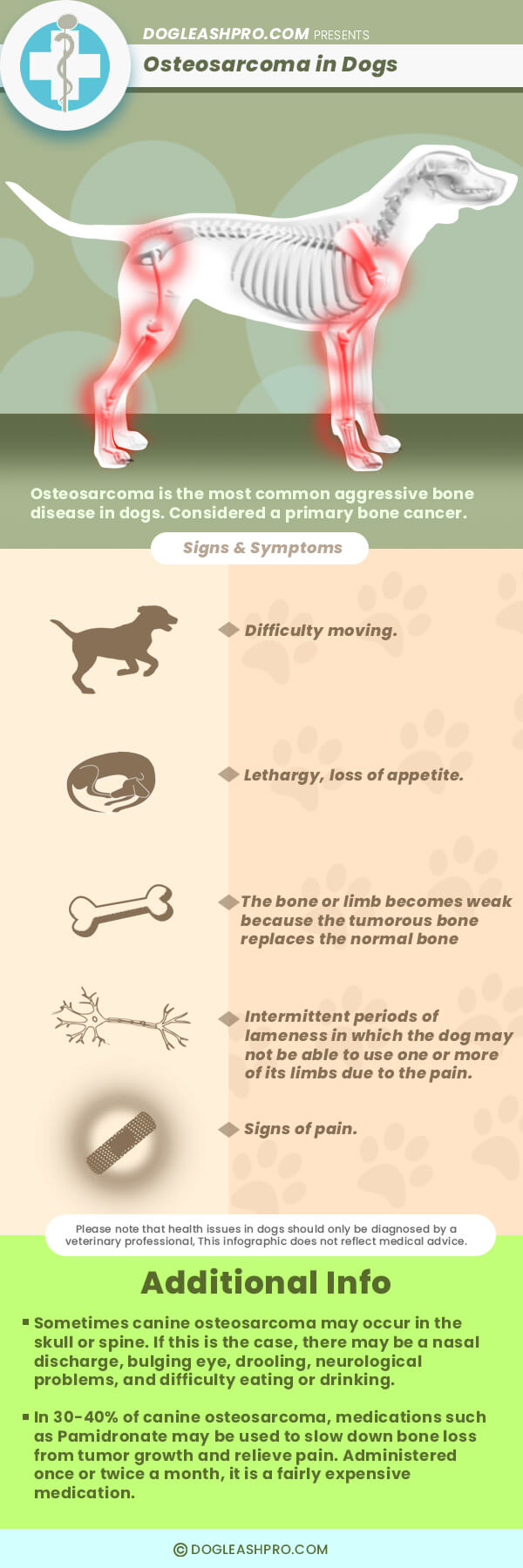
Osteosarcoma diagnosis
Many vets will perform a physical exam to find any swelling or pain at the tumor site. If the cancer is in the leg, your vet may find lameness in your dog’s bone or limb.
Sometimes canine osteosarcoma may occur in the skull or spine. If this is the case, there may be a nasal discharge, bulging eye, drooling, neurological problems, and difficulty eating or drinking.
Vets may also use x-rays to find evidence of metastasis. The vet will x-ray the chest and the bones throughout the whole body. Usually, metastasis in the bones is found earlier than in the lungs.
Some vets may also perform a surgical biopsy since it is the only way to definitively diagnose a bone lesion as cancerous. It helps determine what type of cancer your dog may have.
There could be lab testing. A blood profile is useful to determine the dog’s overall health status and what treatment options they can tolerate.
It may also be worthwhile to perform an ultrasound exam of the abdomen as part of the screening test for metastasis.
If a limb-sparing surgery is being considered for a bone tumor of the leg, the vet may perform an advanced imaging CT scan and other advanced imaging tests.
Unfortunately, by the time osteosarcoma is diagnosed it is very likely that it has already metastasized. Sometimes the diagnostic tests may not even reveal this.
Osteosarcoma in dogs treatment
While there is no cure for canine osteosarcoma, there are several treatment options available to help alleviate pain and extend your dog’s life by months or even years.
There are two types of treatment options:
- Minimize the pain
- Reduce the spread of the disease or control the metastatic of the disease
The first treatment option is palliative radiotherapy with pain medications in which the treatment helps to alleviate the symptoms but it doesn’t eliminate the cause of cancer. This is also known as bisphosphonate infusion treatments.
The second option to relieve the pain is to amputate the limb with the tumor. Amputation along with traditional chemotherapy is a popular choice of treatment that relieves the pain immediately. Most dogs function well after amputation but there is still a high chance of the cancer spreading.
Another option is limb-sparing surgery. A section of the bone that includes the tumor is removed without amputating the entire limb. Both the surgical specialist and your vet will help you decide if this is the best treatment option. It is best to combine this surgery with chemotherapy and post-operative special care is needed.
If the tumor involves the skull or spine, surgical removal may be necessary. It is best to combine this surgery with radiation and/or chemotherapy.
Radiation treatment is used as a follow-up to surgery. Make sure radiation treatment for dogs is available in the state you live in. For instance, radiation treatment for dogs is not available in Maine so you’ll have to take a trip to Massachusetts or New Hampshire.
Chemotherapy usually follows surgery and/or radiation.
In 30-40% of canine osteosarcoma, medications such as Pamidronate may be used to slow down bone loss from tumor growth and relieve pain. Administered once or twice a month, it is a fairly expensive medication.
Nutritional supplements such as fish oil that contains omega 3 and 6 fatty acids may also be a worthwhile treatment option for dogs with osteosarcoma. Many vets recommend using either the Derma-3 Twist Caps or Welactin.
You can also get a complete and balanced dog food called N/D for nutritional support. N/D provides high levels of fat and protein, omega 3 fatty acids, a low level of carbohydrates, and arginine. This combination deprives the cancer cells of nutrition while vitalizing your dog’s immune system.
Some owners prefer holistic treatment for osteosarcoma in dogs using natural at-home remedies.
Osteosarcoma dog prognosis
As you can see, there are several treatment options available if your dog has osteosarcoma but the one pressing question you may have in mind is:
How long can a dog live with osteosarcoma? It depends on what type of osteosarcoma your dogs have and which treatment options they will undergo. When it comes to osteosarcoma, the long-term prognosis even with treatment is unfortunately poor. The prognosis for OSA is usually short-term and dogs will maintain a good quality of life for weeks to months.
We did some digging to provide you with a more specific answer and found the following:
Dogs with OSA of the limbs undergoing amputation without treatment has:
- On average 4 to 5 months of survival time.
- The survival rate of 1 year is 10%, the survival rate of 2 years is 2%.
Dogs with OSA of the limbs undergoing amputation, limb-sparing surgery with platinum-based chemotherapy has:
- On average 10 to 12 months of survival time.
- The 2-year survival rate is 15% to 25%.
Dogs with OSA of the limbs undergoing amputation, limb-sparing surgery with conventional chemotherapy has:
- On average 8 months of survival time.
- The survival rate of 1 year is 35%, the survival rate of 2 years is 17%.
Dogs with tumor in the upper front leg near the shoulder:
- The prognosis is poor.
Dogs with OSA of the limbs undergoing palliative care without surgery or metronomic chemotherapy has:
- On average 4 to 5 months of survival time.
If vets find that the disease has metastasized, then:
- The survival time is less than 2 to 3 months regardless of the treatment options.
Dogs with OSA of the head or spine (not including the mandible) has:
- Similar or worse prognosis to OSA of the limb depending on whether the primary tumor can be removed completely.
Dogs with OSA of the mandible has:
- Prognosis is better than OSA of the head or spine
- Lower metastasis rate than OSA of the limb, head or spine (60% compared to 100%)
- On average 17 months of survival time with mandibulectomy
Dogs with Nasal OSA or Digit OSA has:
- Similar prognosis to OSA of the limb
Canine osteosarcoma prognosis without treatment
Keeping that in mind, canine osteosarcoma prognosis without treatment is usually shorter than if your dog undergoes treatment. Your dog will have on average 5 months of survival time.
If you’re not sure which treatment options to go with or whether you should choose treatments at all, consult with several veterinary professionals. You’ll receive unbias guidance and make the best-informed decision possible.
Ways to help your dog with osteosarcoma
If you can, provide your dog with the best possible treatment option. At home, offer them your best care and provide a comfortable living or sleeping space. We recommend the following elevated dog bed to reduce stress on the joint after lying down for hours.
Deciding if you should euthanize your dog
Nothing can fully prepare dog owners when they learn their dog is diagnosed with osteosarcoma. It’s also heartbreaking to see their dogs suffer from a lot of pain due to this disease. Putting down their dog with this disease is something all dog owners dread.
Depending on what stage of osteosarcoma your dog is at and whether your dog is undergoing treatment, you may have some time before having to make the decision.
If none of the above treatment works, euthanasia will sooner or later be the most reasonable and humane treatment option. If after the treatment and your dog is still experiencing unmanageable pain, speak with your vet if it is the right time to consider euthanization.
Ask yourself the following questions first before deciding if you should euthanize your dog:
- How is your dog’s quality of life?
- Are they able to live comfortably?
- Or are they in constant pain, feeling miserable, and sad?
If your dog is in constant exhausting pain and no longer able to live comfortably, then it may be time to say your farewell to your furry companion. Please know that you are not alone in this process. Speak with your vet to guide you through this decision.
When my best friend made the hard decision to euthanize, she decided to take her furry friend on an adventure to celebrate his last day. They spent the whole afternoon together and he had his favorite meal, steak – top sirloin.
How does dog euthanasia work?
Your dog will lie down on a table for the procedure and your vet will handle the entire procedure and answer any questions you may have.
If you prefer to have this procedure take place in your house, you may choose to go with in-home euthanasia. Ask your vet to see if there are any in-home euthanasia services they’d recommend.
Here’s how dog euthanasia works:
The vet will administer an injection of sodium pentobarbital with a syringe. It is an anesthetic drug that will quickly cause your dog to lose consciousness and painlessly stop the heart. Your vet will then confirm the time of passing by checking for a heartbeat.
You’ll have a few moments with your dog. Think back to any fond memories you had with your furry companion and thank them for all the happy memories they shared with you and your family.
It’s sad that this is the last time you’ll see your furry pup but know that they are now free from pain. You made the humane decision not to see your dog suffer anymore and have given them a painless and quick end to their suffering.
A way to remember your dog
Dog owners can choose to have either a traditional burial (at a pet cemetery or in your yard if your town allows it) or cremation after the euthanization procedure.
Many choose to cremate their beloved furry companion in order to keep the remains in the house within an urn. Some also choose to customize the urn with their favorite memories or quotes.
Pet Insurance
While there are many treatment options available, it can get quite expensive if you’re not prepared. Sadly, there is still no known cure for dogs with osteosarcoma.
If you’re going the treatment route and it’s too expensive, we recommend getting pet insurance. It’s best to get pet insurance before you need it. In case of an emergency, it will help you pay for your dog’s treatment and it will go a long way.
Try not to wait until your pet needs insurance to get it. Signing your dog up to be covered now can help keep monthly payments low and give you peace of mind.
Conclusion
Making the decision to euthanize is a tough choice to make but at the end of the day, it helps to end the suffering of your beloved pet. Always consult with your vet if you have any questions or concerns.
Be aware of signs and symptoms. Early detection is key. It’s always best to know what treatment options are available for dogs with OSA and undergo treatments that will help to alleviate pain and give your dog more time.
You are not alone in this. Ask for help. Veterinary professionals will certainly help and provide additional guidance.
I wish for peace and comfort for all of you and for your dogs.
Related Questions
Once your dog’s vet has officially diagnosed your pooch with osteosarcoma, your pooch may have about two months to live without treatment. This is why we highly recommend that owners sign up for pet insurance early on.
It’s never too late to get pet insurance, but when we find out that our pooch unexpectedly has osteosarcoma, our emotions take over and we may lack clear thinking.
With treatment such as amputation, the survival time increases to 6.5 months. It has been reported that 2% of dogs that underwent treatment actually live up to 2 years.
If your canine friends receive chemotherapy or palliative radiation, they can live up to six months.
Appendicular osteosarcoma or osteosarcoma of the limbs can progress from intermittent to constant within 1 to 3 months. The lameness is initially intermittent when the bone tumor grows deep inside the bone. When the bone tumor continues to grow, it will grow out of the bones.
This means that the dog’s bone is damaged from the inside out and it becomes more painful for your precious pooch. The damaged bone is no longer a normal bone because it is being eaten away and replaced by a tumorous bone.
Dog owners may notice swelling in the dog’s limb as the tumor grows bigger and bigger. As the tumor grows, the bone becomes weaker and weaker. Since the tumorous bone is weak, it can break easily and cause pathologic fracture.
In some cases, this situation and finding would confirm that your pooch has a bone tumor or appendicular osteosarcoma.
DISCLAIMER: THIS WEBSITE DOES NOT PROVIDE MEDICAL ADVICE
The information, including but not limited to, text, graphics, images and other material contained on this website are for informational purposes only. No material on this site is intended to be a substitute for professional veterinary advice, diagnosis, or treatment. Always seek the advice of your veterinarian or other qualified health care provider with any questions you may have regarding a medical condition.

With over five years of specialized experience as an animal writer, my expertise lies in dog nutrition, health, behavior, grooming, and training. I am dedicated to delivering helpful and informative content that caters to the well-being of our furry friends. My primary goal is to empower pet owners with knowledge and ensure our canine companions thrive in health and happiness. In my free time, I love volunteering at local dog rescue centers.






